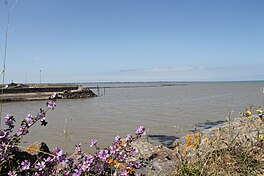| Bay of Bourgneuf | |
|---|---|
| Bay of Brittany | |
| Baie de Bourgneuf (French) | |
 View of the bay from the port du Bec at Bouin. | |
 Bathymetric map | |
| Location | Pays de Retz, Loire-Atlantique,Vendée |
| Coordinates | 47°2′N 2°7′W / 47.033°N 2.117°W |
| Type | Bay |
| Part of | Bay of Biscay |
| River sources | Canal de Haute Perche, Falleron |
| Ocean/sea sources | Atlantic Ocean |
| Basin countries | France |
| Max. length | 27 km (17 mi) |
| Max. width | 17 km (11 mi) |
| Average depth | 10 m (33 ft)[1] |
| Max. depth | 20 m (66 ft)[1] |
| Islands | Noirmoutier |
The Bay of Bourgneuf (French: Baie de Bourgneuf, French pronunciation: [bɛ də buʁnœf]) is a bay situated on the French Atlantic coast, at the border of the Loire-Atlantique and Vendée departments. In the Middle Ages the bay was known as the baie de Bretagne or baye de Bretagne (Bay of Brittany or Brittany Bay).[2]
The bay of Bourgneuf is a vast maritime arc on the French Atlantic coast running from the Pointe Saint-Gildas (south of the Loire estuary) to Beauvoir-sur-Mer and is enclosed by the island of Noirmoutier up to the île du Pilier. It thus includes the south coast of the Pays de Retz, the shore of the Marais breton ('Breton Marshes') and the east coast of Noirmoutier, the latter being connected to the mainland by the notable Passage du Gois and, to the south, the bay connects to the north of the Bay of Biscay by the Strait of Fromentine, crossed by the Noirmoutier Bridge since 1971.
Until the Middle Ages the bay extended over a far greater area. Its shores reached the ports of Machecoul and Challans and was dotted with several islands, notably the Isle of Bouin. Silting of the bed of the bay followed by the creation of the polders and salt pans of the Marais Breton and Noirmoutier, significantly reducing the bay's area.[3]
- ^ a b Lièvre, Claire (2005). "La baie de Bourgneuf : l'artificialisation des milieux" [The Bay of Bourgneuf: the artificialisation of the environment]. Travaux du Laboratoire de Géographie Physique Appliquée (in French). 24 (24): 33–50. doi:10.3406/tlgpa.2005.1029.
- ^ Boutin 1993, pp. 1, 50.
- ^ Villalobos & Ménanteau 2006, Section: Las salines de la baie de Bourgneuf.
